Projects
El Niño could spell trouble for the coffee market
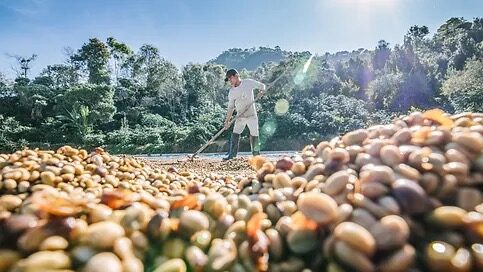
Weather shocks on coffee production and prices
Extreme weather events can be detrimental to coffee crops and impact production at different stages of coffee crop development, many of which are grown in areas already affected by climate change. Coffee is one of the most traded commodities, and as such disruption in its production and supply can have major implications for coffee farming, and by extension for all stakeholders involved in the coffee supply chain.
In past years, the coffee farming community has experienced serious changes in climate conditions, with more erratic precipitations, increased temperatures, and less predictable and distinct seasons, causing a threat not only to the producing community but for all intermediaries along the coffee supply chain.
Flowering usually gets triggered by short rains and stimulates the opening of the flowers. If the rain continues during that period, the flower development is weak. ¹ Too high temperatures can cause flower abortion and less development of the coffee cherries and accelerating ripening. These effects are harmful to both the yield and the quality of the coffee, which may in turn impact coffee price.
In a previous article Roasted by Climate Change: The Dire Consequences for Coffee Production, we assessed the impact of climate change on the production of high-quality coffee in Vietnam during different seasons, using the climate-risk analytics solution developed by our team at Correntics. Here, we show the impact of El Niño on coffee production in Central and South America.
In a previous article Roasted by Climate Change: The Dire Consequences for Coffee Production, we assessed the impact of climate change on the production of high-quality coffee in Vietnam during different seasons, using the climate-risk analytics solution developed by our team at Correntics. Here, we show the impact of El Niño on coffee production in Central and South America.
Forecasting El Niño impact of major coffee regions in Central and South America
El Niño is a naturally occurring coupled ocean-atmosphere phenomenon that typically occurs every two to seven years, typically last 9 to 12 months, and can lead in certain regions to extreme conditions such as droughts, exceptionally high rainfalls, and change in wind patterns. ² Inter-annual variability of climate factors during El Niño can be either beneficial or detrimental to coffee production depending on the growing region, may vary within a single country, and be exacerbated by long-term climate change. ³ Sub-optimal temperatures and precipitation deficits have negative effects on yields and bean quality and can trigger the spread of pests and diseases. The timing of specific climate conditions is also important, as the vulnerability of coffee to climate variables changes depending on the stage of the plant’s life cycle.
El Niño and La Niña phenomena constitute the El Niño Southern Oscillation (ENSO) ², the dominant mode of Pacific Ocean sea-surface temperature (SST) variability, which has been directly linked to world coffee production and prices. ⁴ ⁵ ⁶ Seasonal forecasting can support the coffee industry to anticipate the impact of El Niño on coffee production, reduce economic losses, support the design and implementation of efficient mitigation measures at the farm level (e.g. crop protection, optimize the irrigation system), improve agricultural insurance schemes and hedging strategies, and reduce price volatility.
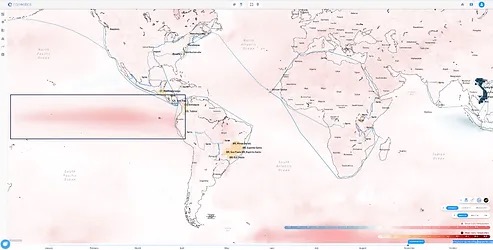
Figure 1: The positive temperature anomaly (increase in mean daily temperature) predicted in the Eastern Pacific Ocean (highlighted with the black square) in September 2023 is a clear signature of El Niño event. The mean daily temperature (in Celsius degrees) is also displayed for many locations in several major regions (colored dots). Source: Correntics climate-risk analytics platform & API.
Figure 2 shows the probability of the most likely category of the mean daily precipitation predicted for September 2023. Significant droughts are predicted in the North of South America, which is a signature of the El Niño phenomenon. At the same time, the West coast of Ecuador and Peru are affected by higher precipitation (compared to the hindcast period 1993-2016). Here we see clearly changes in tendency within the same region, where for example the region of San Paulo will be affected by higher precipitation than the Minas Gerais region according to the predictions.
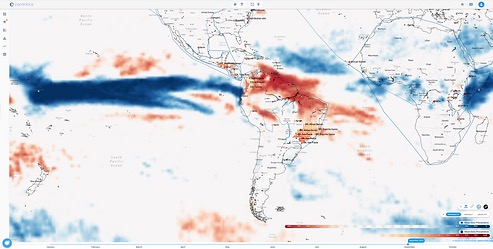
Figure 2: Probability of mean daily precipitation to be above the upper tercile (positive) of the historical hindcast period 1993-2016 or below the lower tercile (negative) forecasted for September 2023 (three-month average). Significant droughts are predicted in the North of South America, which is a signature of El Niño phenomenon. The predicted mean daily precipitation (in absolute value, mm) is also displayed for many locations in several major regions (colored dots). Source: Correntics climate-risk analytics platform & API.
A clear spread of the distribution (all selected locations in all the major producing regions considered) towards higher mean daily temperature and lower mean daily precipitation is indeed predicted in the coming months, as shown on Figure 3 and 4, respectively. These predictions are a clear effect of the El Niño phenomenon and will impact coffee production in the various producing countries with different severity levels.
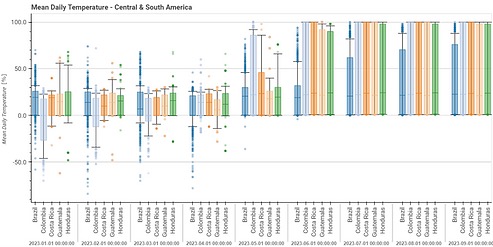
Figure 3: Monthly evolution of the mean daily temperature probability to be above (positive) or below (negative) the upper tercile of the monthly historical hindcast period 1993-2016 in some major coffee-producing countries in Central and South America, predictions from January to September 2023. Plot produced with Correntics’ climate-risk analytics platform.
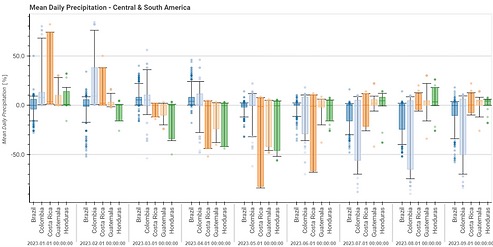
Figure 4: Monthly evolution of the mean daily precipitation probability to be above (positive) or below (negative) the upper tercile of the monthly historical hindcast period 1993-2016 in some major coffee-producing countries in Central and South America, predictions from January to September 2023. Plot produced with Correntics’ climate-risk analytics platform.
Hence, with our seasonal forecast, we can predict which regions will be more impacted by the changes in temperature and precipitation patterns on coffee production in the coming months, due to El Niño phenomenon. El Niño conditions typically also tend to reduce Atlantic hurricane activity and thus reduce the cyclone risk for plantations in Central America.
The capacity to predict the impact of extreme weather events and climate change on coffee production both at the regional and global scale is essential for the coffee sector to de-risk investments, set up efficient sourcing strategies, anticipates potential supply shortages, and implement efficient adaptation measures to build up the resilience of global coffee supply chains.

